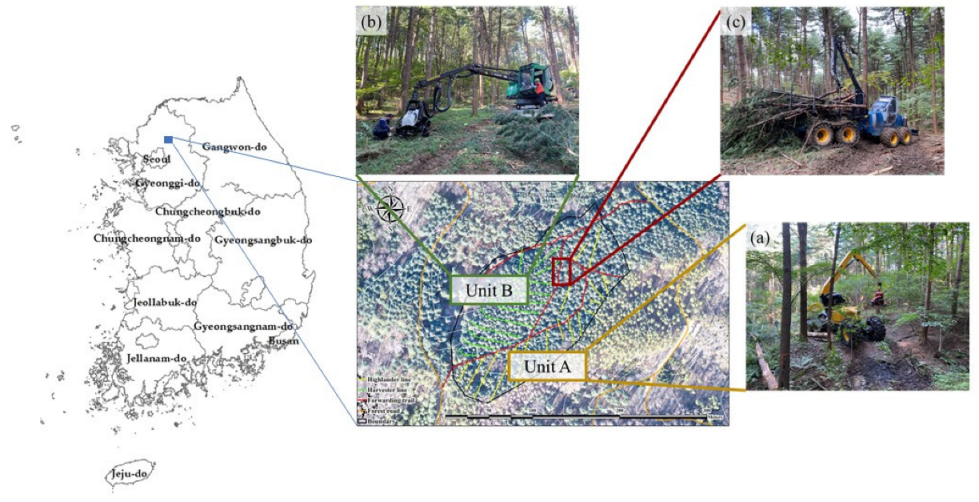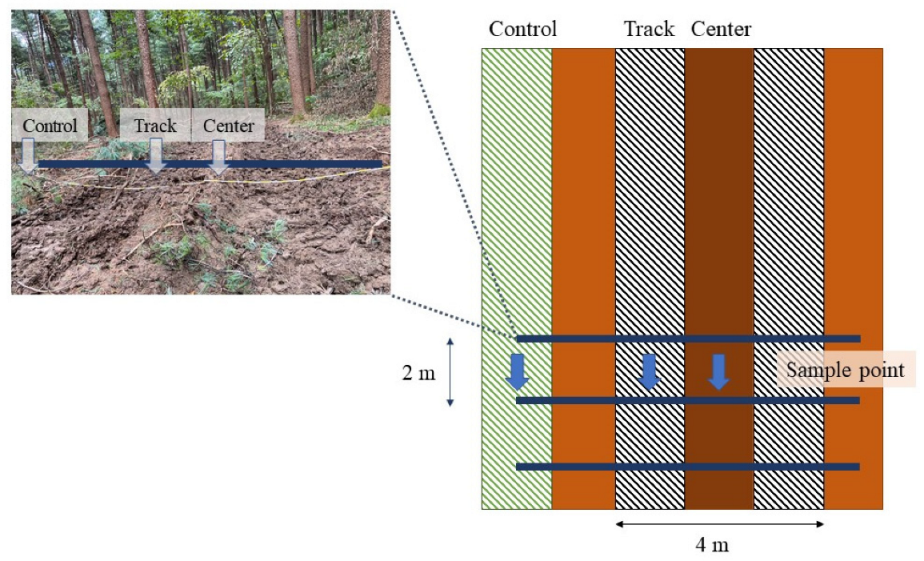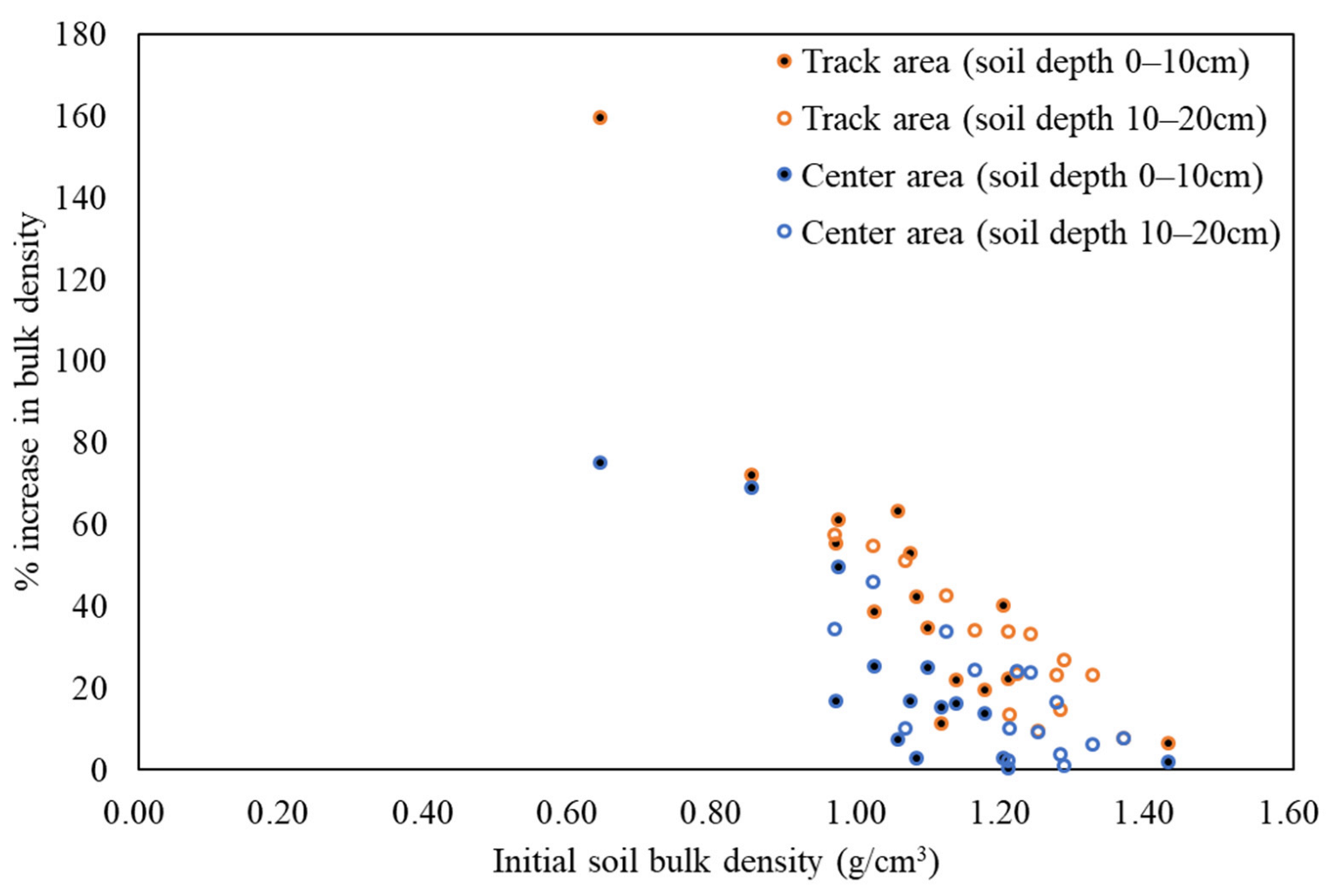Impact on Soil Physical Properties Related to a High Mechanization Level in the Row Thinning of a Korean Pine Stand
Abstract
1. Introduction
2. Materials and Methods
2.1. Description of the Study Area
2.2. Data Collection
2.3. Statistical Analyses
3. Results
3.1. Effects of Harvester Traffic on Soil Compaction
3.2. Effects of Forwarder Traffic on Soil Compaction
4. Discussion
5. Conclusions
Author Contributions
Funding
Institutional Review Board Statement
Informed Consent Statement
Data Availability Statement
Conflicts of Interest
References
- Korea Forest Service. Available online: https://www.forest.go.kr/ (accessed on 28 October 2021).
- Hwang, J.; Bae, S.W.; Lee, K.J.; Lee, K.S.; Kim, H.S. Short-term effect of thinning on aboveground carbon storage in Korean Pine (Pinus koraiensis) plantation. J. Korean For. Soc. 2008, 97, 605–610. [Google Scholar]
- Li, X.; Yi, M.J.; Son, Y.; Park, P.S.; Lee, K.H.; Son, Y.M.; Kim, R.H.; Jeong, M.J. Biomass and carbon storage in an age-sequence of Korean pine (Pinus koraiensis) plantation forests in central Korea. J. Plant Biol. 2010, 54, 33–42. [Google Scholar] [CrossRef]
- World Wide Fund for Nature. Available online: https://wwf.panda.org/ (accessed on 18 February 2022).
- Choung, Y.; Lee, J.; Cho, S.; Noh, J. Review on the succession process of Pinus densiflora forests in South Korea: Progressive and disturbance-driven succession. J. Ecol. Environ. 2020, 44, 1–17. [Google Scholar] [CrossRef]
- Liu, K.; He, H.; Xu, W.; Du, H.; Zong, S.; Huang, C.; Wu, M.; Tan, X.; Cong, Y. Responses of Korean pine to proactive managements under climate change. Forests 2020, 11, 263. [Google Scholar] [CrossRef]
- Chung, C.-H.; Lin, C.-J.; Lin, S.-T.; Huang, C.-Y. Determining ideal timing of row thinning for a cryptomeria japonica plantation using event history analysis. Forests 2017, 8, 77. [Google Scholar] [CrossRef]
- Picchio, R.; Venanzi, R.; Latterini, F.; Marchi, E.; Laschi, A.; Monaco, A.L. Corsican pine (Pinus laricio Poiret) stand management: Medium and long lasting effects of thinning on biomass growth. Forests 2018, 9, 257. [Google Scholar] [CrossRef]
- Korean Law Information Center. Available online: https://www.law.go.kr/ (accessed on 11 November 2021).
- Anderson, W.C. Mechanized Row-Thinning Systems in Slash Pine Plantations; Southern Forest Experiment Station, Forest Service, U.S. Department of Agriculture: Washington, DC, USA, 1974; p. 12. [Google Scholar]
- Fujimori, T. Ecological and silvicultural strategies for sustainable forest management. In Thinning; Elsevier: Amsterdam, The Netherlands, 2001; pp. 160–161. [Google Scholar]
- Crawford, L.J.; Heinse, R.; Kimsey, M.J.; Page-Dumroese, D.S. Soil Sustainability and Harvest Operations: A Review; U.S. Department of Agriculture, Forest Service, Rocky Mountain Research Station: Washington, DC, USA, 2021. [Google Scholar]
- Picchio, R.; Mederski, P.S.; Tavankar, F. How and how much, do harvesting activities affect forest soil, regeneration and stands? Curr. For. Rep. 2020, 6, 115–128. [Google Scholar] [CrossRef]
- Poltorak, B.J.; Labelle, E.R.; Jaeger, D. Soil displacement during ground-based mechanized forest operations using mixed-wood brush mats. Soil Tillage Res. 2018, 179, 96–104. [Google Scholar] [CrossRef]
- Allman, M.; Jankovský, M.; Messingerová, V.; Allmanová, Z.; Ferenčík, M. Soil compaction of various Central European forest soils caused by traffic of forestry machines with various chassis. For. Syst. 2015, 24, e038. [Google Scholar] [CrossRef]
- Eroğlu, H.; Sariyildiz, T.; Küçük, M.; Sancal, E. The effects of different logging techniques on the physical and chemical characteristics of forest soil. Balt. For. 2016, 22, 139–147. [Google Scholar]
- Lee, E.; Li, Q.; Eu, S.; Han, S.K.; Im, S. Influences of timber harvesting methods on soil disturbance. J. Korean Soc. For. Sci. 2017, 106, 204–212. [Google Scholar] [CrossRef]
- Han, H.-S.; Page-Dumroese, D.; Han, S.-K.; Tirocke, J. Effects of slash, machine passes, and soil moisture on penetration resistance in a cut-to-length harvesting. Int. J. For. Eng. 2006, 17, 11–24. [Google Scholar] [CrossRef]
- Page-Dumroese, D.S.; Jurgensen, M.F.; Tiarks, A.E.; Ponder, J.F.; Sanchez, F.G.; Fleming, R.L.; Kranabetter, J.M.; Powers, R.F.; Stone, D.M.; Elioff, J.D.; et al. Soil physical property changes at the North American long-term soil productivity study sites: 1 and 5 years after compaction. Can. J. For. Res. 2006, 36, 551–564. [Google Scholar] [CrossRef]
- Lang, A.; Cristan, R.; Aust, W.; Bolding, M.; Strahm, B.; Vance, E.; Roberts, E. Long-term effects of wet and dry site harvesting on soil physical properties mitigated by mechanical site preparation in coastal plain loblolly pine (Pinus taeda) plantations. For. Ecol. Manag. 2016, 359, 162–173. [Google Scholar] [CrossRef]
- Naghdi, R.; Solgi, A.; Labelle, E.R.; Nikooy, M. Combined effects of soil texture and machine operating trail gradient on changes in forest soil physical properties during ground-based skidding. Pedosphere 2020, 30, 508–516. [Google Scholar] [CrossRef]
- Lee, E.; Li, Q.; Eu, S.; Han, S.-K.; Im, S. Assessing the impacts of log extraction by typical small shovel logging system on soil physical and hydrological properties in the Republic of Korea. Heliyon 2020, 6, e03544. [Google Scholar] [CrossRef]
- Jones, M.-F.; Arp, P. Soil trafficability forecasting. Open J. For. 2019, 9, 296–322. [Google Scholar] [CrossRef][Green Version]
- Hwang, K.; Han, H.-S.; Marshall, S.E.; Page-Dumroese, D.S. Soil compaction from cut-to-length thinning operations in young redwood forests in northern California. Can. J. For. Res. 2020, 50, 185–192. [Google Scholar] [CrossRef]
- Han, S.-K.; Han, H.-S.; Page-Dumroese, D.S.; Johnson, L.R. Soil compaction associated with cut-to-length and whole-tree harvesting of a coniferous forest. Can. J. For. Res. 2009, 39, 976–989. [Google Scholar] [CrossRef]
- Labelle, E.R.; Poltorak, B.J.; Jaeger, D. The role of brush mats in mitigating machine-induced soil disturbances: An assessment using absolute and relative soil bulk density and penetration resistance. Can. J. For. Res. 2019, 49, 164–178. [Google Scholar] [CrossRef]
- Wood, M.J.; Carling, P.A.; Moffat, A.J. Reduced ground disturbance during mechanized forest harvesting on sensitive forest soils in the UK. Forestry 2003, 76, 345–361. [Google Scholar] [CrossRef][Green Version]
- Han, Y.; Zhang, J.; Mattson, K.G.; Zhang, W.; Weber, T.A. Sample sizes to control error estimates in determining soil bulk density in California forest soils. Soil Sci. Soc. Am. J. 2016, 80, 756–764. [Google Scholar] [CrossRef]
- Mroz, G.D.; Reed, D.D. Forest soil sampling efficiency: Matching laboratory analyses and field sampling procedures. Soil Sci. Soc. Am. J. 1991, 55, 1413–1416. [Google Scholar] [CrossRef]
- Korea Meteorological Administration. Available online: https://www.kma.go.kr/kma/ (accessed on 13 February 2022).
- Ampoorter, E.; de Schrijver, A.; van Nevel, L.; Hermy, M.; Verheyen, K. Impact of mechanized harvesting on compaction of sandy and clayey forest soils: Results of a meta-analysis. Ann. For. Sci. 2012, 69, 533–542. [Google Scholar] [CrossRef]
- Allman, M.; Dudáková, Z.; Jankovský, M.; Vlčková, M.; Juško, V.; Tomčík, D. Soil compaction after increasing the number of wheeled tractors passes on forest soils in west Carpathians. Forests 2022, 13, 109. [Google Scholar] [CrossRef]
- Cambi, M.; Certini, G.; Fabiano, F.; Foderi, C.; Laschi, A.; Picchio, R. Impact of wheeled and tracked tractors on soil physical properties in a mixed conifer stand. iForest -Biogeosciences For. 2016, 9, 89–94. [Google Scholar] [CrossRef]
- Picchio, R.; Neri, F.; Petrini, E.; Verani, S.; Marchi, E.; Certini, G. Machinery-induced soil compaction in thinning two pine stands in central Italy. For. Ecol. Manag. 2012, 285, 38–43. [Google Scholar] [CrossRef]
- Page-Dumroese, D.; Jurgensen, M.; Elliot, W.; Rice, T.; Nesser, J.; Collins, T.; Meurisse, R. Soil quality standards and guidelines for forest sustainability in northwestern North America. For. Ecol. Manag. 2000, 138, 445–462. [Google Scholar] [CrossRef]
- Sheridan, G.J. A comparison of rubber-tyred and steel-tracked skidders on forest soil physical properties. Aust. J. Soil Res. 2003, 41, 1063–1075. [Google Scholar] [CrossRef]
- Jansson, K.-J.; Johansson, J. Soil changes after traffic with a tracked and a wheeled forest machine: A case study on a silt loam in Sweden. Forestry 1998, 71, 57–66. [Google Scholar] [CrossRef]
- Spinelli, R.; Magagnotti, N.; Nati, C. Benchmarking the impact of traditional small-scale logging systems used in Mediterranean forestry. For. Ecol. Manag. 2010, 260, 1997–2001. [Google Scholar] [CrossRef]
- Wenger, A.S.; Atkinson, S.C.; Santini, T.; Falinski, K.; Hutley, N.; Albert, S.; Horning, N.; Watson, J.; Mumby, P.; Jupiter, S.D. Predicting the impact of logging activities on soil erosion and water quality in steep, forested tropical islands. Environ. Res. Lett. 2018, 13, 044035. [Google Scholar] [CrossRef]
- Binkley, D.; Fisher, R.F. Ecology and Management of Forest Soils, 4th ed.; Wiley-Blackwell: Hoboken, NJ, USA, 2013; p. 362. [Google Scholar]
- Hatten, J.; Liles, G. A ‘healthy’ balance—The role of physical and chemical properties in maintaining forest soil function in a changing world. In Developments in Soil Science; Elsevier: Amesterdam, The Netherlands, 2019; Volume 36, pp. 373–396. [Google Scholar] [CrossRef]
- Williamson, J.R.; A Neilsen, W. The influence of forest site on rate and extent of soil compaction and profile disturbance of skid trails during ground-based harvesting. Can. J. For. Res. 2000, 30, 1196–1205. [Google Scholar] [CrossRef]
- Cambi, M.; Paffetti, D.; Vettori, C.; Picchio, R.; Venanzi, R.; Marchi, E. Assessment of the impact of forest harvesting operations on the physical parameters and microbiological components on a Mediterranean sandy soil in an Italian stone pine stand. Eur. J. For. Res. 2017, 136, 205–215. [Google Scholar] [CrossRef]
- Marra, E.; Laschi, A.; Fabiano, F.; Foderi, C.; Neri, F.; Mastrolonardo, G.; Nordfjell, T.; Marchi, E. Impacts of wood extraction on soil: Assessing rutting and soil compaction caused by skidding and forwarding by means of traditional and innovative methods. Eur. J. For. Res. 2021, 141, 71–86. [Google Scholar] [CrossRef]
- Venanzi, R.; Picchio, R.; Grigolato, S.; Latterini, F. Soil and forest regeneration after different extraction methods in coppice forests. For. Ecol. Manag. 2019, 454, 117666. [Google Scholar] [CrossRef]
- Venanzi, R.; Picchio, R.; Spinelli, R.; Grigolato, S. Soil Disturbance and recovery after coppicing a Mediterranean oak stand: The effects of silviculture and technology. Sustainability 2020, 12, 4074. [Google Scholar] [CrossRef]
- Cambi, M.; Grigolato, S.; Neri, F.; Picchio, R.; Marchi, E. Effects of forwarder operation on soil physical characteristics: A case study in the italian alps. Croat. J. For. Eng. 2016, 37, 233–239. [Google Scholar]
- McDonald, T.; Way, T.; Löfgren, B.; Seixas, F. Load and inflation pressure effects on soil compaction of forwarder tires. Can. Pulp. Pap. Assoc. 1996, 67–70. [Google Scholar]
- Labelle, E.R.; Hansson, L.; Högbom, L.; Jourgholami, M.; Laschi, A. Strategies to mitigate the effects of soil physical disturbances caused by forest machinery: A comprehensive review. Curr. For. Rep. 2022. [Google Scholar] [CrossRef]
- Picchio, R.; Jourgholami, M.; Zenner, E.K. Effects of forest harvesting on water and sediment yields: A review toward better mitigation and rehabilitation strategies. Curr. For. Rep. 2021, 7, 214–229. [Google Scholar] [CrossRef]






| Thinning Unit | |||
|---|---|---|---|
| Unit A | Unit B | Combined | |
| Area (ha) | 1.4 | 1.2 | 2.6 |
| Mean DBH a (cm) | 31.8 | 28.5 | 30.2 |
| Mean height (m) | 18.8 | 19.1 | 19.0 |
| Basal area (m2/ha) | 51.8 | 61.4 | 56.5 |
| Trees per hectare | 624 | 902 | 760 |
| Stand volume (m3/ha) | 445.1 | 569.9 | 506.4 |
| Soil texture | Clay loam | Sandy clay loam | - |
| Unit | Soil Depth (cm) | n | Reference | Track | Center | p-Value |
|---|---|---|---|---|---|---|
| Bulk density (g/cm3) | ||||||
| A | 0–10 | 16 | 1.05 ± 0.04 a | 1.23 ± 0.03 b | 1.02 ± 0.04 a | 0.0002 |
| 10–20 | 16 | 1.11 ± 0.05 a | 1.41 ± 0.03 b | 1.11 ± 0.05 a | <0.001 | |
| B | 0–10 | 15 | 1.07 ± 0.05 a | 1.39 ± 0.04 b | 1.18 ± 0.03 a | 0.0002 |
| 10–20 | 15 | 1.20 ± 0.03 a | 1.42 ± 0.02 b | 1.22 ± 0.03 a | <0.001 | |
| Porosity (%) | ||||||
| A | 0–10 | 16 | 59 ± 0.02 a | 53 ± 0.01 b | 61 ± 0.01 a | <0.001 |
| 10–20 | 16 | 57 ± 0.02 a | 43 ± 0.01 b | 57 ± 0.02 a | <0.001 | |
| B | 0–10 | 15 | 59 ± 0.02 a | 47 ± 0.01 b | 55 ± 0.01 a | <0.001 |
| 10–20 | 15 | 54 ± 0.01 a | 46 ± 0.01 b | 53 ± 0.01 a | <0.001 | |
| Unit | n | Rut Depth (cm) |
|---|---|---|
| A | 16 | 10.5 ± 0.54 |
| B | 15 | 9.0 ± 0.56 |
| Soil Depth (cm) | n | Reference | Track | Center | p-Value | |
|---|---|---|---|---|---|---|
| Bulk density (g/cm3) | ||||||
| Trails | 0–10 | 15 | 1.06 ± 0.03 a | 1.50 ± 0.04 b | 1.24 ± 0.04 c | <0.001 |
| 10–20 | 15 | 1.15 ± 0.03 a | 1.54 ± 0.02 b | 1.28 ± 0.10 c | <0.001 | |
| Porosity (%) | ||||||
| Trails | 0–10 | 15 | 59 ± 0.01 a | 42 ± 0.01 b | 52 ± 0.02 c | <0.001 |
| 10–20 | 15 | 56 ± 0.01 a | 41 ± 0.01 b | 51 ± 0.04 c | <0.001 | |
Publisher’s Note: MDPI stays neutral with regard to jurisdictional claims in published maps and institutional affiliations. |
© 2022 by the authors. Licensee MDPI, Basel, Switzerland. This article is an open access article distributed under the terms and conditions of the Creative Commons Attribution (CC BY) license (https://creativecommons.org/licenses/by/4.0/).
Share and Cite
Baek, K.; Lee, E.; Choi, H.; Cho, M.; Choi, Y.; Han, S. Impact on Soil Physical Properties Related to a High Mechanization Level in the Row Thinning of a Korean Pine Stand. Land 2022, 11, 329. https://doi.org/10.3390/land11030329
Baek K, Lee E, Choi H, Cho M, Choi Y, Han S. Impact on Soil Physical Properties Related to a High Mechanization Level in the Row Thinning of a Korean Pine Stand. Land. 2022; 11(3):329. https://doi.org/10.3390/land11030329
Chicago/Turabian StyleBaek, Kigwang, Eunjai Lee, Hyungtae Choi, Minjae Cho, Yunsung Choi, and Sangkyun Han. 2022. "Impact on Soil Physical Properties Related to a High Mechanization Level in the Row Thinning of a Korean Pine Stand" Land 11, no. 3: 329. https://doi.org/10.3390/land11030329
APA StyleBaek, K., Lee, E., Choi, H., Cho, M., Choi, Y., & Han, S. (2022). Impact on Soil Physical Properties Related to a High Mechanization Level in the Row Thinning of a Korean Pine Stand. Land, 11(3), 329. https://doi.org/10.3390/land11030329






